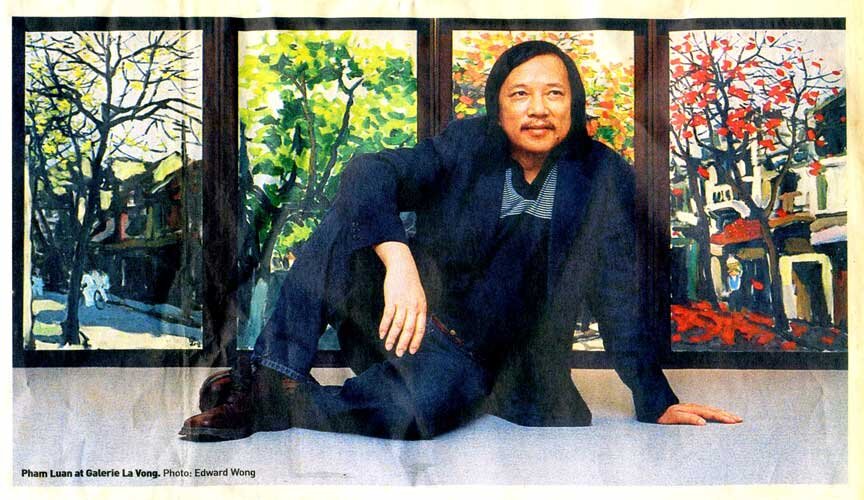The Broader View
by Victoria Finlay
Travel has given Vietnamese artist Pham Luan a better appreciation of his homeland, writes Victoria Finlay
Pham Luan at Galerie La Vong
Pham Luan specialises in painting dappled, bright, nostalgic street scenes of Hanoi. But far from bewailing the modernisation that has transformed the picturesque city he has loved all his life, the 48-year-old Vietnamese artist welcomes it. “The renovations help me,” he says cheerfully. “I grew up in a very old city and now it is full of new things. But I like the changes, especially people’s clothes. They are much more colourful today – much more interesting for an artist.”
For Pham Luan, whose exhibition opens today at Galerie La Vong in Lan Kwai Fong, the big change has been his own growing opportunities to travel. “Travelling has given me a broader view of the world and has helped my paintings,” he says. When asked to give an example, he says, decisively: “Van Gogh.”
In 1999, he went to New York for the first time and he returned there last year for another show. When he wasn’t representing his own work at the gallery that had invited him, he could be found in the Impressionist rooms at the Metropolitan Museum of Art. He utters the word “Metropolitan” with a gleam in his eye and says it is one of the most important experiences in his life. “I would just stand in front of one painting for an hour or more,” he says. Before he went to New York, he had only been able to see the works of Vincent van Gogh and Claude Monet in poor reproduction – now he could work out how the paintings had been created and experience the texture of the paint and the energy of the artists.
He points to a large canvas he painted of cherry blossoms growing in ordered lines just before Vietnamese New Year. In terms of technique the scene is in the style of the Impressionists – bold splashes of pure colour showing an outdoor scene that could almost be set in Provence, France – and Pham Luan agrees it is strongly inspired by what he saw and learned in New York.
Inspiration from other artists is one thing. But copying is quite another. And that is one of the big problems in Vietnam: any remotely successful artist is imitated. “In the beginning it really upsets me,” Pham Luan says. But later he realised there was no point being upset because it was going to happen if he continued to live in Vietnam. “There are some people who are happy to buy something without any spirit,” he says. “But there are still very many who buy something with a real sense of life. And as long as they stay around, then I will be able to make a living.”
Unlike the Impressionists, who did the bulk of their work outdoors, Pham Luan prefers to paint in the studio, partly out of personal choice but partly because of the chaos and pollution of his home city. It means he sometimes lacks the immediacy of an artist working outside and the sand or dust on his canvas, but it does mean he can put together his idea of a place he has visited many times.
The first time he sketches a particular place he usually goes there in sunshine – hence the splashy dapples between poplar shadows that characterise his street scenes. “But I do not usually paint the scene until I have gone back again when it is raining,” he says. To understand a place fully, he feels he needs to see it in both good and bad light.
Pham Luan started working in the 1970s as a teacher of technical drawing. His students learned how to draw steps and cubes in perfect perspective, for use in architecture or in planning or design.
His work nowadays is the opposite of that meticulous geometry. The sense of figurativeness in his scenes comes from swirls of pure paint that look like light shining through leaves – not from mathematically accurate perspective or technical neatness.
“It isn’t a conflict,” he says. His work isn’t a reaction against the work he had to do to earn a living in the past. “One is the bread and the other is the spirit. I taught drawing to earn money, so that I could one day be an artist. And now I am.”

